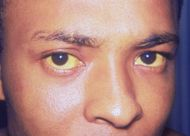
Jaundice
Presented by
Dr. Pawan S. Chandak
Introduction: Jaundice, also known as icterus (attributive adjective: "icteric"), is yellowish discoloration of the skin, conjunctiva (a clear covering over the sclera, or whites of the eyes) and mucous membranes caused by hyperbilirubinemia (increased levels of bilirubin in the blood).
This hyperbilirubinemia subsequently causes increased levels of bilirubin in the extracellular fluids.
Typically, the concentration of bilirubin in the plasma must exceed 1.5 mg/dL[1], three times the usual value of approximately 0.5mg/dL, for the coloration to be easily visible. Jaundice comes from the French word 'jaune', meaning yellow.

Yellowing of the skin and sclera caused by Hepatitis A.
Causes:
When a pathological process interferes with the normal functioning of the metabolism and excretion of bilirubin just described, jaundice may be the result.
Jaundice is classified into three categories, depending on which part of the physiological mechanism the pathology affects.
The three categories are:
Pre-hepatic: The pathology is occurring prior the liver
Hepatic: The pathology is located within the liver
Post-Hepatic: The pathology is located after the conjugation of bilirubin in the liver
Pre-hepatic:
Pre-hepatic jaundice is caused by anything which causes an increased rate of hemolysis (breakdown of red blood cells). In tropical countries, malaria can cause jaundice in this manner. Certain genetic diseases, such as sickle cell anemia, spherocytosis and glucose 6-phosphate dehydrogenase deficiency can lead to increased red cell lysis and therefore hemolytic jaundice. Commonly, diseases of the kidney, such as hemolytic uremic syndrome, can also lead to coloration. Defects in bilirubin metabolism also present as jaundice. Jaundice usually comes with high fevers.
Laboratory findings include:
Urine: no bilirubin present, urobilirubin > 2 units (except in infants where gut flora has not developed).
Serum: increased unconjugated bilirubin.
Hepatic
Hepatic jaundice causes include acute hepatitis, hepatotoxicity and alcoholic liver disease, whereby cell necrosis reduces the liver's ability to metabolise and excrete bilirubin leading to a buildup in the blood. Less common causes include primary biliary cirrhosis, Gilbert's syndrome (a genetic disorder of bilirubin metabolism which can result in mild jaundice, which is found in about 5% of the population) and metastatic carcinoma. Jaundice seen in the newborn, known as neonatal jaundice, is common, occurring in almost every newborn as hepatic machinery for the conjugation and excretion of bilirubin does not fully mature until approximately two weeks of age.
Laboratory Findings include:
Urine: bilirubin present, Urobilirubin > 2 units but variable (Except in children)
Post-hepatic
Post-hepatic jaundice, also called, is caused by an interruption to the drainage of bile in the biliary system. The most common causes are gallstones in the common bile duct, and pancreatic cancer in the head of the pancreas. Also, a group of parasites known as "liver flukes" live in the common bile duct, causing obstructive jaundice. Other causes include strictures of the common bile duct, biliary atresia, ductal carcinoma, pancreatitis and pancreatic pseudocysts. A rare cause of obstructive jaundice is Mirizzi's syndrome.
The presence of pale stools and dark urine suggests an obstructive or post-hepatic cause as normal feces get their color from bile pigments.
Patients also can present with elevated serum cholesterol, and often complain of severe itching or "pruritus".
Laboratory Results
|
|
Pre-hepatic Jaundice |
Hepatic Jaundice |
Post-hepatic Jaundice |
|
Total bilirubin |
Normal / Increased |
Increased |
Increased |
|
Conjugated bilirubin |
Normal |
Normal / Increased |
Increased |
|
Unconjugated bilirubin |
Increased |
Normal / Increased |
Normal |
|
|
Healthy Individual |
Pre-hepatic Jaundice |
Hepatic Jaundice |
Post-hepatic Jaundice |
|
Urine urobilinogen |
Present |
Increased |
Increased |
- |
|
Urine bilirubin |
- |
- |
Increased |
Increased |
Jaundiced eye
It was once believed persons suffering from the medical condition jaundice saw everything as yellow. By extension, the jaundiced eye came to mean a prejudiced view, usually rather negative or critical. Alexander Pope, in 'An Essay on Criticism' (1711), wrote: "All seems infected that the infected spy, As all looks yellow to the jaundiced eye."
References
http://en.wikipedia.org/wiki/Jaundice